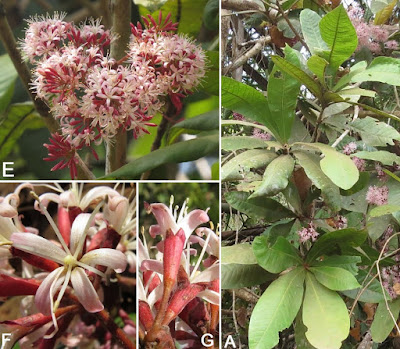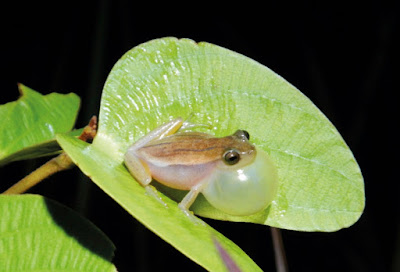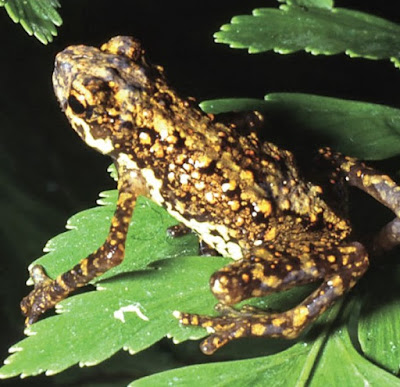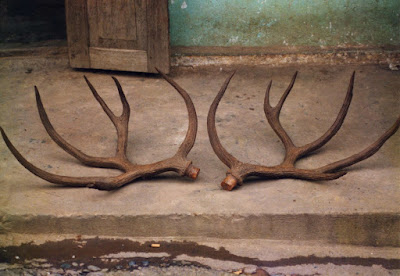[Most Recent Entries] [Calendar View]
Sunday, September 8th, 2019
| Time | Event | ||||||
| 8:44a | [Botany • 2019] Gluta laosensis (Anacardiaceae) • A New Species from Vientiane, Laos
Abstract A new species of Gluta (Anacardiaceae), Gluta laosensis Tagane & Kameda, from Vientiane, Central Laos, is described and illustrated. A new species is easily distinguished from the other species of the genus in Indo-China in having short petioles less than 4 mm long, obovate-oblong or oblong-elliptic leaf blade with rounded to slightly cordate base, and 18–24 pairs of secondary veins. Keywords: flora, Indochina, Sapindales, taxonomy, Eudicots Gluta laosensis Tagane & Kameda, sp. nov. (Fig 1.) TYPE:—LAOS. Vientiane Capital: Sangthong District, Napo Village, 220 m elev., ..., 25 Feb. 2018, Kameda K164 [fl.] (holotype FOF!; isotype P). Similar to Gluta velutina Blume in leaf shape, short petiole to 4 mm long (to 7 mm in G. velutina) and fruits without winglike petals but differs in lower leaf more or less covered with brown hairs (vs. glabrous in G. velutina), pubescent petals (vs. glabrous), and smooth reniform-fruits (vs. pale brown scurfy and subglobose, with irregularly tuberculate ridges at base). ... Distribution:—LAOS. Vientiane Capital (so far known only from Sangthong District). Habitat and Ecology:— In mixed deciduous forest, disturbed semi-evergreen forest on hills, characterized by a typical monsoon climate with a distinct rainy (May to November) and dry season (December to April); 200–310 m elevation. Flowering specimens were collected in February and fruiting specimens in June. Etymology:—The specific epithet refers to the country in which this species is found. Vernacular name:—ນ້ຳກ້ຽງນ້ອຍ (Nam kiang noy). Note:— Gluta laosensis is easily distinguished from the other species of the genus in Indo-China in having short petioles less than 4 mm long, obovate-oblong or oblong-elliptic leaf shape, rounded to slightly cordate leaf base, and 18–24 pairs of secondary veins. Gluta velutina distributed in Indonesia (Java, Kalimantan, Sumatra), Malaysia (Borneo, Peninsular), Myanmar, Thailand (Peninsula) and Vietnam is apparently similar in leaf shape, but in addition to the diagnosis mentioned above, they differ in their habitats: G. laosensis grows in mixed deciduous forest and secondary semi-evergreen forest, while G. velutina grows at edge of tidal rivers (Kochummen 1996, Chayamarit 2010). Shuichiro Tagane, Chika Kameda, Souphachay Phouphasouk and Phetlasy Souladeth. 2019. Gluta laosensis (Anacardiaceae), A New Species from Vientiane, Laos. Phytotaxa. 415(3); 153–156. DOI: 10.11646/phytotaxa.415.3.6 | ||||||
| 9:22a | [Invertebrate • 2019] Ophionereis commutabilis • Dark Offshoot: Phylogenomic Data Sheds Light on the Evolutionary History of A New Species of Cave Brittle Star
Highlights: • Species delimitation methods and morphology validated a new species of cave brittle star. • Successful colonisation of anchihaline caves by brittle stars has been very rare. • The origin of Ophionereis commutabilis does not conform fully to models on the origin of cave taxa. • Cave brittle stars do not share convergent morphological traits association with cave-life. Abstract Caves are a useful system for testing evolutionary and biogeographic hypotheses, as they are isolated, and their environmental conditions have resulted in adaptive selection across different taxa. Although in recent years many more cave species have been discovered, cave-dwelling members of the class Ophiuroidea (brittle stars) remain scarce. Out of the more than two thousand species of brittle stars described to date, only three are regarded as true cave-dwellers. These occurrences represent rare colonising events, compared to other groups that are known to have successfully diversified in these systems. A third species from an anchihaline cave system in the Yucatan Peninsula, Mexico, has been previously identified from cytochrome oxidase I (COI) barcodes. In this study, we reassess the species boundaries of this putative cave species using a phylogenomic dataset (20 specimens in 13 species, 100 exons, 18.7 kbp). We perform species delimitation analyses using robust full-coalescent methods for discovery and validation of hypotheses on species boundaries, as well as infer its phylogenetic relationships with species distributed in adjacent marine regions, in order to investigate the origin of this cave-adapted species. We assess which hypotheses on the origin of subterranean taxa can be applied to this species by taking into account its placement within the genus Ophionereis and its demographic history. We provide a detailed description of Ophionereis commutabilis n. sp., and evaluate its morphological characters in the light of its successful adaptation to life in caves. Keywords: Ophiuroidea, Ophionereis, Anchihaline cave, Multispecies coalescent, Species delimitation Taxonomy Family OPHIONEREIDIDAE Ljungman, 1867 Genus Ophionereis Lütken (1859) Ophionereis commutabilis n. sp. Etymology: From the feminine Latin adjective commutabilis meaning ‘changeable’ or ‘variable’, in reference to the variable colouration pattern; and ‘adaptable’, as this species successfully adapted to the harsh conditions of an anchihaline cave. Guadalupe Bribiesca-Contreras, Tania Pineda-Enríquez, Francisco Márquez-Borrás, Francisco A. Solís-Marín, Heroen Verbruggen, Andrew F. Hugall, Timothy D. O'Hara. 2019. Dark Offshoot: Phylogenomic Data Sheds Light on the Evolutionary History of A New Species of Cave Brittle Star. Molecular Phylogenetics and Evolution. 136; 151-163. DOI: 10.1016/j.ympev.2019.04.014 Descubren nueva especie marina en la isla de Cozumel @Gaceta_UNAM gaceta.UNAM.mx/?p=36866 | ||||||
| 1:51p | [Herpetology • 2019] Dendropsophus rozenmani • A New Striped Species of Dendropsophus (Anura: Hylidae) with A Composite Advertisement Call and Comments on the D. rubicundulus group
Herein we describe Dendropsophus rozenmani sp. nov. based on morphological, bioacoustic, and molecular data. This new species is distinguished from other species of Dendropsophus by its small size (SVL 18.7–21.1 mm in adult males and 19.6–23.2 mm in females); in life, dorsal ground coloration brown, with two anterior parallel and straight, dark brown stripes and a middorsal sacral stripe; and lateral limits of dorsal coloration above tympanum. In addition, the new species differs from all other species of the D. rubicundulus group (along with D. anataliasiasi) by having a composite advertisement call, i.e., a series of calls consisting of two call types. In a phylogenetic tree based on 494 bp of the 16S mitochondrial gene, four species of Dendropsophus, D. cruzi, D. juliani, and D. sanborni and one candidate species, D. juliani A, are positioned within the rubicundulus species group which poses questions on the monophyly of this group as well as its morphological definition. The occurrence of both single and composite calls in the D. rubicundulus group suggests future studies on the call evolution in that group as well as the whole genus. Key words: Advertisement call; Amphibia; bioacoustics; Cerrado; Chiquitanía; Dendropsophus tritaeniatus; species delimitation; taxonomy.
Dendropsophus rozenmani sp. nov. Dendropsophus tritaeniatus – Jansen et al. (2011) Hyla tritaeniata – Reichle & Köhler (1996), Reichle (1997), Reichle & Köhler (1998), De la Riva et al. (2000), Márquez et al. (2002) Diagnosis. A species of the genus Dendropsophus that is assigned to the D. microcephalus species group based on the results of a molecular analysis of a fragment of the 16S rRNA gene, general morphological appearance, and overall call structure. Further, it is tentatively assigned to the D. rubicundulus group (fde Napoli & Caramaschi, 1998) based on morphological and molecular data awaiting further studies on the monophlyly of this group. Dendropsophus rozenmani is distinguished from other species of Dendropsophus by the following combination of characters: (1) small size, SVL 18.7 –21.1 mm in adult males and 19.6–23.2 mm in females; (2) head longer than wide; (3) snout short, rounded in dorsal view, acute to protruding in lateral view; (4) canthus rostralis rounded, loreal region slightly concave; (5) tympanum indistinct or not visible; (6) skin on dorsal surfaces smooth; (7) in life, dorsal ground coloration brown, with two anterior parallel and straight, dark brown stripes and a middorsal sacral stripe; (8) lateral limits of dorsal coloration above tympanum; (9) composite advertisement call consisting of two types of pulsed calls (type “A” and type “B”) that are emitted usually in series starting with one call type A and followed by 1 to 12 calls type B; call type A is 42 seconds in average long and has 3 – 9 pulses; type B is in average 12 ms long and has 1–3 pulses; dominant frequency of both call types is around 4100 Hz. ... Etymology. The specific name is a patronym for Jaime Rozenman, one of the owners of Caparú Ranch, Bolivia, in recognition of his long-lasting logistic support of taxonomic research on his property, and in honor of his great effort for conservation of the local fora and fauna. Martin Jansen, Diego José Santana, Bernardo Franco da Veiga Teixeira and Gunther Köhler. 2019. A New Striped Species of Dendropsophus (Anura: Hylidae) with A Composite Advertisement Call and Comments on the D. rubicundulus group. Vertebrate Zoology. 69(3): 227-246. DOI: 10.26049/VZ69-3-2019-01 | ||||||
| 3:04p | [Herpetology • 2019] Pelophryne ingeri • A New Species of Pelophryne (Anura, Bufonidae) from Malay Peninsula
Abstract A small, semi-arboreal toad of the genus Pelophryne from Peninsular Malaysia has been treated as P. brevipes or P. signata. The peninsular toad and Bornean P. signata are very similar to each other morphologically, although slightly different in relative forelimb length, dorsal coloration, and tuberculation. However, in partial mtDNA sequence, the peninsular toad is substantially distinct from P. signata from Borneo and P. brevipes from the Philippines, although it is close to a congener from Sumatra. Thus, the peninsular toad is described as a new species based on specimens from Genting Highlands, state of Pahang, central Peninsular Malaysia. Of the two morphotypes recognized in the genus, the new species belongs to the one with the tips of the fingers expanded into truncate discs, in which the new species is the smallest in body size. The new species also occurs in Singapore and possibly in Sumatra. KEYWORDS: body size, cryptic species, Malaysia, MtDNA phylogeny, Pelophryne ingeri sp. nov
Systematics: Pelophryne ingeri sp. nov. Pelophryne signata: Hendrickson, 1966, p. 73 (part). Pelophryne brevipes: Grandison, 1972, p. 54 (part); Berry, 1975, p. 55 (part). Diagnosis: The new species is placed in the genus Pelophryne by having the fingers and toes with a peculiar, fleshy web. A small Pelophryne, adult males 16–17 mm; tips of fingers expanded into truncate discs; disk of third finger slightly smaller than tympanum; tibiotarsal articulation of adpressed limb reaching to posterior corner of eye; dorsum clay brown, with a cruciform pattern outlined by darker bands; creamy band extending from below eye to groin, merging on flank with creamy abdomen with small dark spots; males with mandibular spines and nuptial pad. ...
Holotype: KUHE 15647, an adult male collected near a pond in Genting Highlands, State of Pahang, Malaysia (..., 850 m a.s.l.) by M. Matsui and K. Araya on 17 January 1993. Paratype: KUHE 35585, an adult male, data same as the holotype. Etymology: The specific name is dedicated to the late Dr. Robert F. Inger, Emeritus Curator of the Field Museum of Natural History, Chicago, for his great contributions to Southeast Asian herpetology, including taxonomy of Pelophryne. Masafumi Matsui. 2019. A New Species of Pelophryne from Malay Peninsula (Anura, Bufonidae). Current Herpetology. 38(2); DOI: 10.5358/hsj.38.128 | ||||||
| 3:09p | [Mammalogy • 2019] Evidence of Late Survival of Schomburgk's Deer Rucervus schomburgki in Central Laos
A rare deer species that lived in central Thailand might have come back from the dead — without the help from sci-fi-like genetic engineering. Schomburgk’s deer (Rucervus schomburgki) was added to the extinction list in 1938. But new evidence, gleaned from antlers obtained in late 1990 or early 1991, shows that it survived for at least an additional half century and might still be around today. The research was published last week (Aug. 30 [DOI: 10.17087/jbnhs/2019/v116/142873]) in the Journal of the Bombay Natural History Society. Gary Galbreath, professor of biological sciences at Northwestern University’s Weinberg College of Arts and Sciences, was involved in the work. After the wild population died out from overhunting in 1932, the last known Schomburgk’s deer died in captivity six years later. Or so we thought. A trucker in Laos found a set of antlers, seemingly in fresh condition, in the early 1990s. He then gave the antlers to a shop in the northern Laos province of Phongsali. In February 1991, United Nations agronomist Laurent Chazée photographed the antlers. Galbreath and his collaborator G.B. Schroering recently analyzed the antlers’ physical condition in those photos. Based on the widely spreading, basket-shaped, hyper-branched structure of the antlers, the team determined the antlers belonged to a Schomburgk’s deer. (Other Asian deer’s antlers do not have the same signature basket shape.) Galbreath also confirmed that the antlers were fresh when photographed in 1991. The antlers — spotted with dark red to reddish-brown dried blood — had been excised from the deer’s head. The color of the blood and condition of the exposed bone marrow offered clues into the antlers’ age. “The relative antiquity of the antler specimens can be assessed by the materials, such as dried marrow, still adhering to them,” said Galbreath, an expert in Asian wildlife. “Even the blood was still reddish; it would become black with increased age. In the tropics, the antlers would not continue to look this way even within a matter of months.” Before they were listed as “extinct,” the deer were well documented in Thailand. Galbreath believes a small population probably also lived in a remote area in central Laos, where they just might still be living today. G. B. Schroering and Gary J. Galbreath. 2019. Evidence of Late Survival of Schomburgk's Deer Rucervus schomburgki in Central Laos. Journal of Bombay Natural History Society (JBNHS). 116. DOI: 10.17087/jbnhs/2019/v116/142873 Evidence suggests rare deer lived 50 years beyond 'extinction' phys.org/news/2019-09-evidence-rare-deer-y Giles, F.H. 1937. The riddle of Cervus schomburgki. J. Siam Soc. Nat. Hist. Suppl. 11 (1): 1-34 + 4 pls. |
| << Previous Day |
2019/09/08 [Calendar] |
Next Day >> |





















